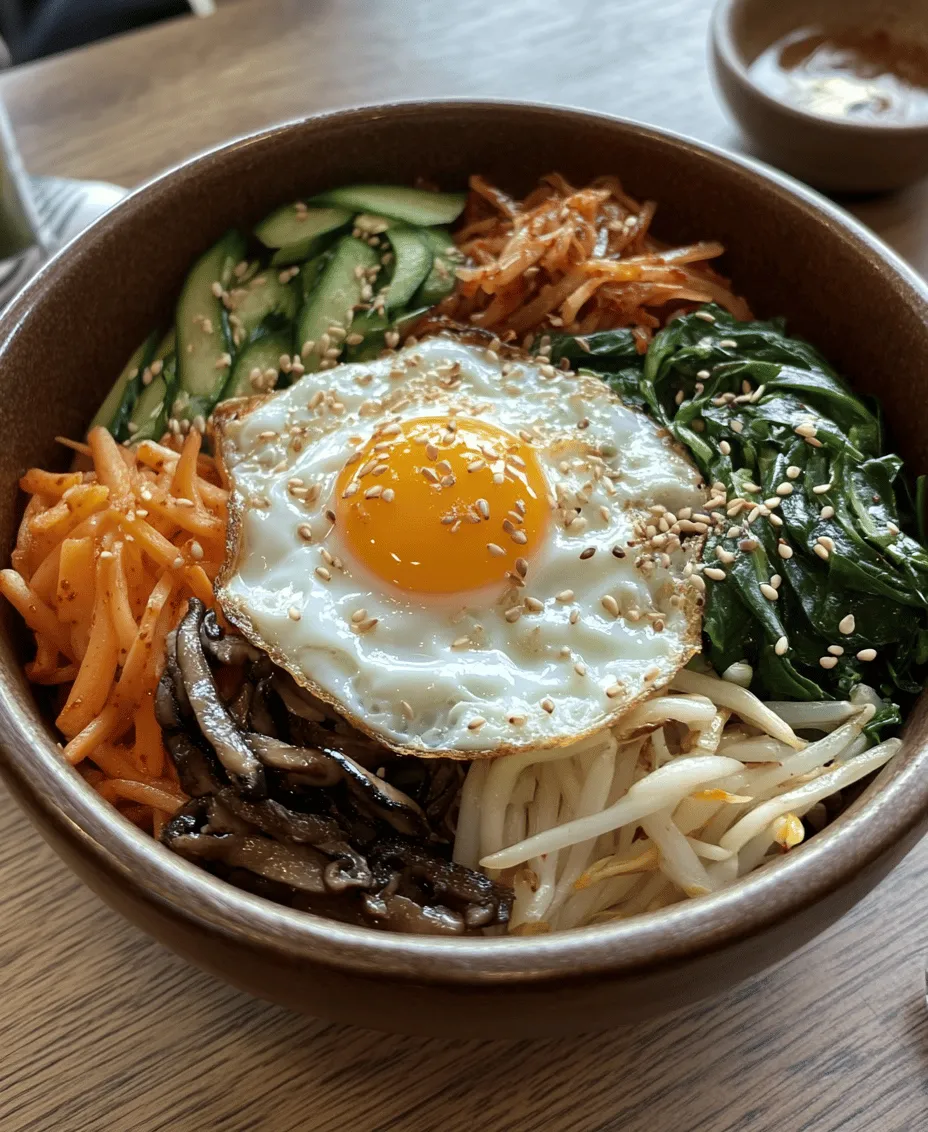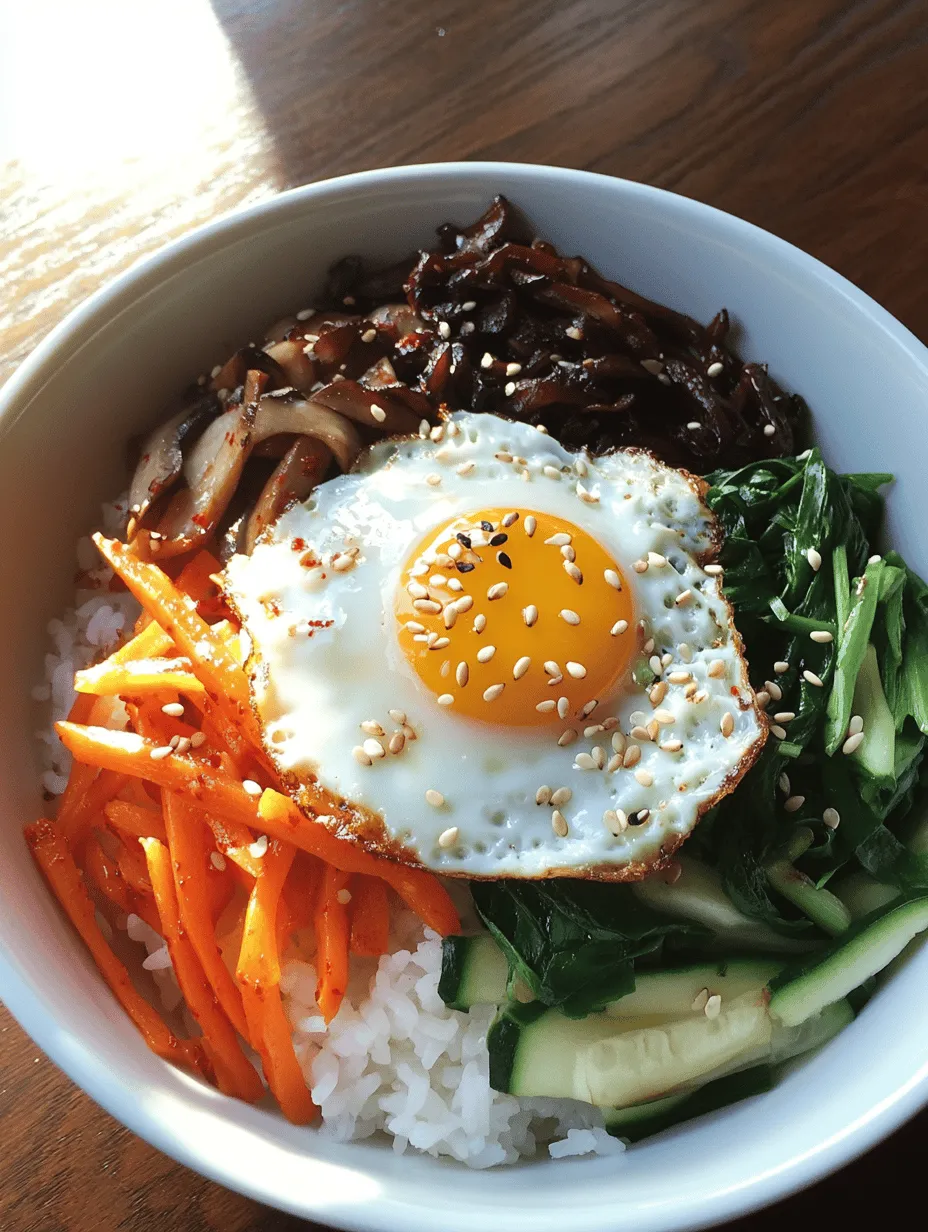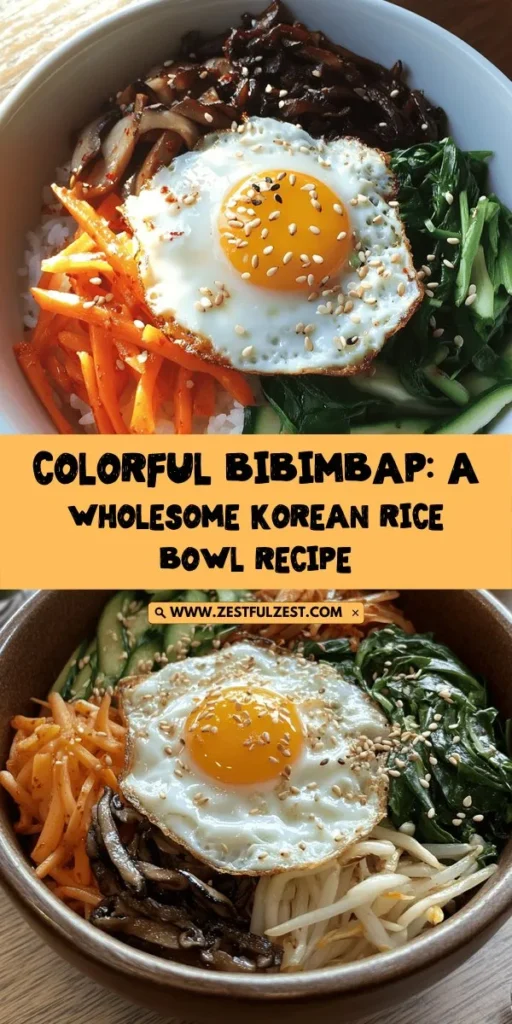Introduction
Bibimbap, a traditional Korean rice bowl dish, is a vibrant culinary masterpiece that represents the essence of Korean cuisine. Known for its delightful mix of flavors, textures, and colors, Bibimbap has transcended its humble origins to become a beloved dish both in Korea and around the world. The name “Bibimbap” literally translates to “mixed rice,” and it perfectly encapsulates the dish’s charm, which lies in its combination of rice topped with a variety of vegetables, protein, and a flavorful sauce.
The cultural significance of Bibimbap extends beyond just its delicious taste. It is often regarded as a symbol of harmony and balance, showcasing how diverse ingredients can come together to create something extraordinary. Traditionally enjoyed during festive occasions and family gatherings, Bibimbap is not only a feast for the eyes but also a celebration of community and sharing.
One of the most appealing aspects of Bibimbap is its health benefits. This dish is a powerhouse of nutrition, packed with an array of colorful vegetables that provide essential vitamins, minerals, and antioxidants. Each ingredient contributes to a well-rounded meal, making it an excellent choice for those seeking to maintain a balanced diet. Additionally, Bibimbap is incredibly versatile; it can be easily customized to accommodate various dietary preferences, whether vegetarian, vegan, or meat-lover.
Whether you are a seasoned chef or a beginner in the kitchen, preparing Bibimbap is a straightforward process that can be completed in under an hour. The colorful presentation combined with the delightful mix of flavors makes this dish not only satisfying to eat but also fun to prepare. So, let’s dive into the world of Bibimbap and discover how to create your very own Colorful Bibimbap Delight!
Understanding Bibimbap: A Culinary Classic
Bibimbap’s origins can be traced back to the late 19th century during the Joseon Dynasty in Korea. The dish was initially prepared as a simple meal for farmers and laborers, utilizing leftover vegetables and rice. Traditionally, it was served as a way to ensure nothing went to waste, embodying the Korean philosophy of valuing all food.
Over the years, Bibimbap has evolved, and today there are numerous regional variations that showcase the unique flavors and ingredients of different areas in Korea. For instance, Jeonju Bibimbap, originating from the city of Jeonju, is known for its use of high-quality ingredients and a special emphasis on beef, while the Busan variation often includes seafood, reflecting the coastal region’s bounty.
The significance of the ingredients used in traditional Bibimbap cannot be understated. Each vegetable and protein adds its own flavor profile and nutritional value, creating a symphony of tastes in every bite. The dish is typically served with a fried egg on top, symbolizing prosperity and good fortune. The addition of gochujang (Korean chili paste) and sesame oil elevates the dish, bringing depth and complexity to the overall flavor.
Bibimbap is not just a meal; it is an experience. The act of mixing the ingredients together before eating is an integral part of enjoying Bibimbap, allowing diners to appreciate the harmony of flavors and textures. As you prepare your Colorful Bibimbap Delight, you will be engaging in this age-old tradition, creating a dish that is both delicious and deeply rooted in Korean culture.
Ingredient Breakdown for Colorful Bibimbap Delight
Creating a delicious Colorful Bibimbap Delight begins with selecting the right ingredients. The beauty of this dish lies in its vibrant array of vegetables, which not only add color but also provide a wealth of health benefits. Below is an overview of the essential ingredients you’ll need for this recipe:
Essential Ingredients
1. Rice: The foundation of any Bibimbap is the rice, typically jasmine or short-grain rice, which offers a slightly sticky texture that holds the ingredients together. Jasmine rice is fragrant and adds a lovely aroma to the dish, while short-grain rice is traditional for its stickiness, making it easy to mix with other ingredients.
2. Spinach: This leafy green is a powerhouse of nutrients, rich in iron, vitamins A and C, and antioxidants. Spinach not only adds vibrant color to your Bibimbap but also contributes to overall health and well-being.
3. Carrots: Shredded carrots bring a natural sweetness and crunch to the dish. Packed with beta-carotene, which converts to vitamin A in the body, carrots support healthy vision and skin.
4. Zucchini: Low in calories and high in water content, zucchini is an excellent addition for those looking to add volume without extra calories. It also provides a mild flavor that complements the other ingredients.
5. Shiitake Mushrooms: Known for their rich, umami flavor, shiitake mushrooms are not only delicious but also packed with antioxidants and immune-boosting properties. Their chewy texture adds depth to the dish.
6. Eggs: A fried egg is a staple in traditional Bibimbap, serving as a protein source that enhances the dish’s richness. The runny yolk adds a creamy texture when mixed with the rice and vegetables.
7. Gochujang: This fermented chili paste is a key flavor component in Bibimbap. It adds a spicy and slightly sweet kick, elevating the overall taste of the dish. Gochujang is also rich in probiotics, promoting gut health.
8. Sesame Oil: A drizzle of sesame oil adds a nutty flavor that rounds out the dish. It is a source of healthy fats and enhances the aroma of the Bibimbap.
Nutritional Advantages of Each Vegetable
1. Spinach: Rich in iron and vitamins, spinach helps improve energy levels and supports overall health.
2. Carrots: With high levels of beta-carotene, carrots promote healthy skin and vision.
3. Zucchini: Low in calories and high in water content, zucchini aids in hydration and weight management.
4. Shiitake Mushrooms: Packed with antioxidants, shiitake mushrooms help boost the immune system and combat inflammation.
The combination of these ingredients not only makes for a visually stunning dish but also ensures that you are nourishing your body with essential nutrients. As you prepare this Colorful Bibimbap Delight, you will be indulging in a meal that is as healthy as it is delicious.
Step-by-Step Guide to Preparing Colorful Bibimbap
Now that you have gathered all the necessary ingredients, it’s time to start preparing your Colorful Bibimbap Delight. Here’s a step-by-step guide to ensure that you achieve the perfect texture and flavor in your dish, beginning with the most crucial element: the rice.
Cooking the Rice
1. Rinse the Rice: Begin by rinsing 1 cup of jasmine or short-grain rice under cold water until the water runs clear. This step removes excess starch, which can make the rice gummy. Rinsing the rice helps achieve a fluffy texture.
2. Soak the Rice: After rinsing, soak the rice in fresh water for about 30 minutes. This helps the grains absorb water, allowing for even cooking.
3. Cook the Rice: Drain the soaked rice and transfer it to a rice cooker or pot. Add 1.5 cups of water (adjust based on your rice type and cooking method) and a pinch of salt. If using a rice cooker, simply select the appropriate setting and let it cook. If cooking on the stovetop, bring the water to a boil, then reduce the heat to low, cover, and simmer for about 15-20 minutes, or until the water is absorbed.
4. Fluff the Rice: Once cooked, remove the rice from heat and let it sit covered for an additional 10 minutes. Then, fluff the rice with a fork to separate the grains and prevent clumping.
With the rice cooked to perfection, you’re now ready to prepare the colorful vegetables and assemble your delightful Bibimbap. Each step in the process is crucial for achieving a harmonious blend of flavors, and the vibrant hues of your ingredients will create an inviting and appetizing presentation.
Stay tuned for the next part of this article, where we will dive into preparing the vegetables and assembling your Colorful Bibimbap Delight.

Sautéing Vegetables
When it comes to creating the perfect Colorful Bibimbap, the sautéed vegetables play a crucial role in enhancing both flavor and texture. For this dish, we will focus on three key vegetables: carrots, zucchini, and mushrooms. Each vegetable brings its unique taste and contributes to the vibrant color palette that makes bibimbap so visually appealing.
Best Practices for Cooking Carrots, Zucchini, and Mushrooms
1. Carrots: Start by julienning your carrots into thin matchstick shapes. This will ensure they cook quickly and evenly. Heat a tablespoon of sesame oil in a skillet over medium heat. Add the carrots and sauté for about 2-3 minutes until they become slightly tender but still retain a bit of crunch. Season with a pinch of salt to enhance their natural sweetness.
2. Zucchini: Similar to the carrots, slice the zucchini into thin strips. Zucchini has a high water content, so it’s important not to overcook it. In the same skillet (after removing the carrots), add a little more sesame oil and sauté the zucchini for about 2 minutes, just until it starts to soften. Season lightly with salt and pepper.
3. Mushrooms: Use shiitake or button mushrooms for this recipe. Clean them with a damp cloth and slice them thinly. Add them to the skillet with a bit more oil if necessary, and sauté for about 4-5 minutes until they are golden brown and have released their moisture. Season with soy sauce or a sprinkle of salt to amplify their umami flavor.
Importance of Seasoning and Timing
Timing and seasoning are key to achieving the best flavors. Each vegetable should be cooked just enough to enhance its natural taste without losing its crunch. Remember that the seasoning should be subtle; you want to enhance the vegetables without overshadowing their individual flavors.
Preparing the Spinach
Spinach is another essential component of bibimbap. The preparation method can greatly affect its flavor and texture.
Techniques for Blanching and Flavoring
1. Blanching: Bring a pot of water to a boil and prepare an ice bath in a separate bowl. Place the spinach in the boiling water for about 30 seconds until it wilts. Immediately transfer the spinach to the ice bath to stop the cooking process. This method retains the vibrant green color and crisp texture.
2. Flavoring: Once cooled, squeeze out excess water from the spinach and chop it coarsely. In a small bowl, mix a teaspoon of sesame oil, a dash of soy sauce, and a sprinkle of sesame seeds. Toss the spinach in this mixture to infuse it with flavor.
Cooking the Eggs
A perfectly cooked sunny-side-up egg is a hallmark of bibimbap, adding richness to the dish.
How to Achieve the Ideal Sunny-Side-Up Yolk
1. Heat a non-stick skillet over medium-low heat and add a dab of oil. Crack the egg gently into the skillet, being careful not to break the yolk.
2. Cover the skillet with a lid to trap steam, which will help cook the top of the egg without flipping it. Cook for about 3-4 minutes or until the whites are set, but the yolk remains runny.
3. Season lightly with salt and pepper just before removing it from the pan.
Assembling Your Bibimbap Bowl
Now that all the components are prepared, it’s time to assemble your Colorful Bibimbap Bowl.
Visual Presentation: Importance of Arranging Ingredients in Sections
The presentation of bibimbap is not only for aesthetics; it also enhances the dining experience. Start with a bowl of warm, cooked rice as the base. Neatly arrange the sautéed carrots, zucchini, mushrooms, and seasoned spinach in separate sections around the rice.
Tips for Creating a Visually Appealing Dish
– Color Contrast: Choose a variety of colorful vegetables to create a vibrant display. The contrast of green spinach, orange carrots, and brown mushrooms will make your dish pop.
– Height and Texture: Consider adding a few slices of avocado or edamame for texture and visual interest. These elements can create height and variation in your bowl.
– Garnishing: Top the dish with the sunny-side-up egg in the center and sprinkle sesame seeds and sliced green onions for a finishing touch.
How to Serve and Enjoy Bibimbap
Bibimbap is traditionally served with gochujang (Korean chili paste) on the side. Before eating, mix all the ingredients together, allowing the flavors to meld. The warm rice will soften the vegetables, and the runny egg yolk will create a delicious sauce for the dish.
Exploring Variations and Customizations
One of the great things about bibimbap is its versatility. You can easily customize it to suit your dietary preferences or seasonal availability.
Suggestions for Adding Protein Alternatives
– Tofu: For a vegetarian option, consider adding marinated and grilled tofu. Simply cube firm tofu, marinate it in soy sauce and sesame oil, and grill or sauté until golden.
– Chicken or Beef: For meat lovers, thinly sliced marinated chicken or beef can be added. Marinate the protein in a mixture of soy sauce, garlic, and ginger for added flavor before cooking.
Vegetarian and Vegan Adaptations
Bibimbap naturally lends itself to vegetarian and vegan diets. Simply omit any animal products and increase the variety of vegetables or add plant-based proteins such as chickpeas or lentils.
Seasonal Vegetable Options for Year-Round Enjoyment
Depending on the season, you can swap in different vegetables. In spring, consider adding asparagus or radishes. Summer is perfect for fresh bell peppers, while in the fall, consider using roasted pumpkin or sweet potatoes.
Exploring Alternative Sauces and Spices for Flavor Enhancement
While gochujang is a traditional choice, feel free to experiment with other sauces like sriracha, tahini, or even a homemade peanut sauce for a unique twist. Adjust the amount based on your heat tolerance and flavor preferences.
Nutritional Insights of Colorful Bibimbap
Bibimbap is not only delicious but also a balanced meal that offers a variety of nutrients.
Comprehensive Breakdown of the Nutritional Profile
1. Vegetables: Packed with vitamins and minerals, the array of vegetables contributes fiber and antioxidants, supporting overall health.
2. Protein: Depending on your choice of protein, bibimbap can provide essential amino acids, which are crucial for tissue repair and muscle growth.
3. Healthy Fats: Ingredients like sesame oil and avocado add healthy fats that are important for heart health.
Benefits of Eating a Balanced Meal
Eating a balanced meal like bibimbap helps maintain energy levels and supports overall well-being. The combination of carbohydrates from rice, proteins from eggs or meat, and a wide variety of vegetables makes it a wholesome choice.
Discussing Portion Control and Healthy Eating Practices
Bibimbap allows for portion control, as you can adjust the amount of rice and toppings to fit your dietary needs. Mixing the ingredients also encourages mindful eating, making it easier to enjoy each component of the dish.
Conclusion
The Colorful Bibimbap Delight is more than just a meal; it’s a celebration of flavors, colors, and nutrition. This dish not only provides a feast for the eyes but also offers a balanced array of nutrients that contribute to a healthy diet. Whether you’re looking for a quick weeknight dinner or a dish to impress at gatherings, bibimbap can easily fit the bill.
Encouraging your family to try this vibrant dish can enhance their appreciation for healthy eating. Cooking and sharing meals like bibimbap can forge connections and create lasting memories. Embrace the joy of cooking and the delight of sharing this beloved Korean meal with your loved ones. It’s time to gather around the table and enjoy the colorful journey of flavors that bibimbap brings.



